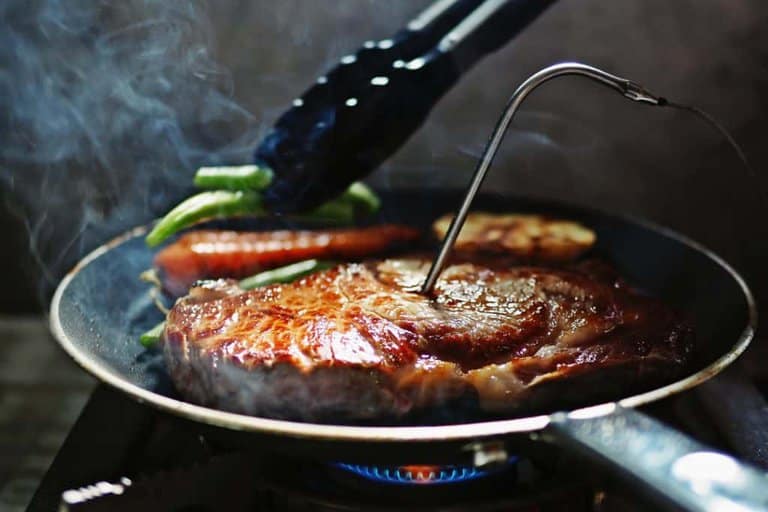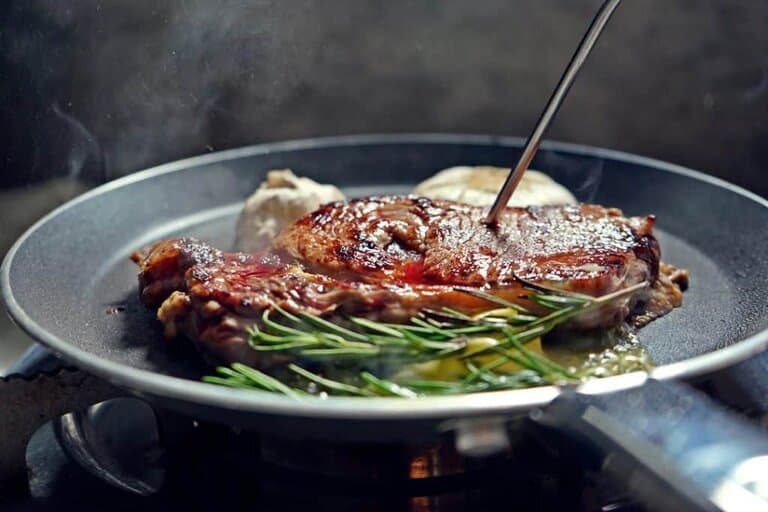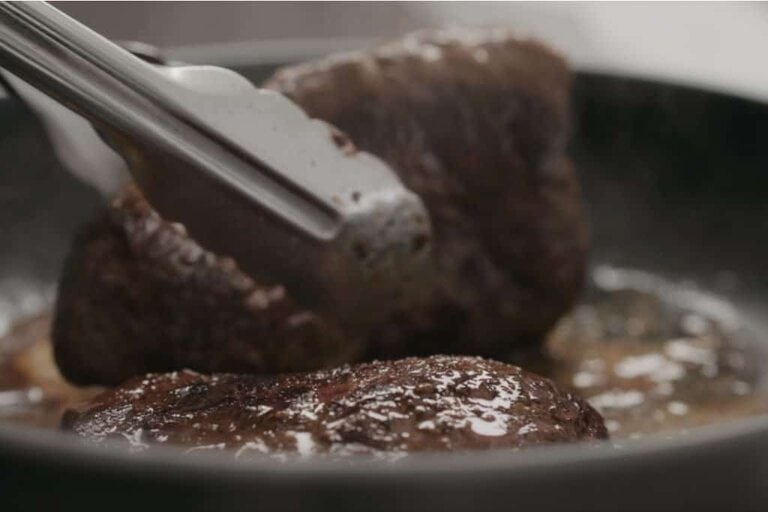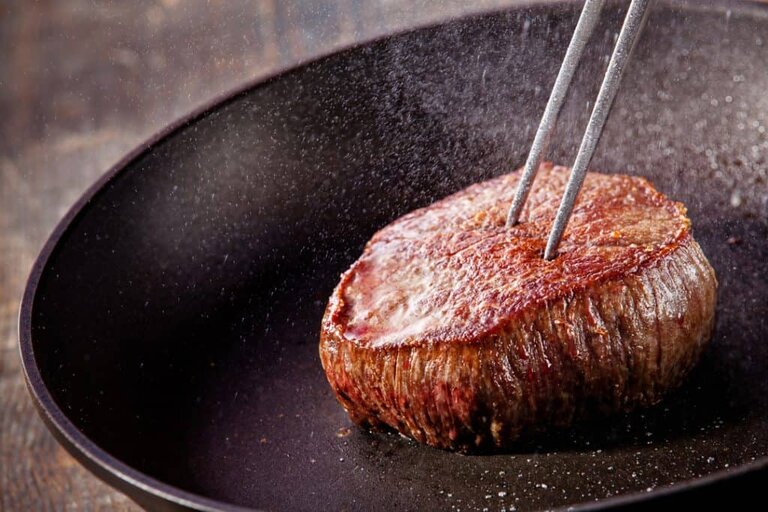You can technically sear a steak in a nonstick pan, but it won’t turn out as good as it should. The meat will be dry and may lack a juicy flavor. You also risk poisoning because nonstick pans can release toxins when heated at high temperatures needed for searing a steak.
The humble nonstick pan has, for many years, been touted as a kitchen essential. This is because they conduct heat well and release food easily, making cooking a breeze.
These features make the nonstick pans quite versatile and great for sauteing, frying, and scrambling eggs. However, If you’re looking for a seared and well-flavored steak with juicy goodness on the inside, a nonstick pan is not the best way to go.
In this article, I’ll explain why nonstick pans are not the best choice to sear a steak and walk you through better alternatives that guarantee a better steak taste.

Why You Shouldn’t Use A Nonstick Pan To Sear Steak
Although I like nonstick pans for most cooking tasks and use them regularly, there are several reasons why chefs like me stay away from searing steak in them.
Adaptability
Proper searing requires intense heat, and nonstick pans don’t have enough surface area to handle the heat needed to render a steak correctly. Also, If you constantly heat steak in a non-stick pan, the pan may begin to break down and lose its ability to retain heat.
Toxicity
At extremely high temperatures, The Teflon in nonstick pans can give off fumes that contain toxic substances. So, it is important to only use your non-stick pans at low-medium temperatures and never leave your pans unattended.
Nonstick pans are made with Teflon, which can be an extremely toxic substance at high temperatures. When most Teflon reaches 300°C, it starts to give out poisonous smoke that could lead to health hazards like fever and headache.
Time Consuming
A nonstick surface doesn’t transfer heat as quickly as a cast iron or stainless steel pan. So your cooking time will be dependent on the thickness and size of your meat, but it could take up to an hour to properly sear a steak in a nonstick pan.
Use A Cast Iron or Stainless Steel As A Better Alternative
Searing your steak in cast iron or stainless steel is the ultimate way to lock in the flavor of the steak and start the cooking process at the same time. This will also help your steak retain more moisture and tenderness, making the steak more enjoyable.:
How To Use Stainless Steel For Searing Your Steak
A stainless skillet allows Maximum contact with your steak. And unlike nonstick pans, it wouldn’t get affected when superheated. In fact, the process is so simple and stress-free.
But before we jump into the searing process, below are a few things you should keep in mind in order to get the best out of your steak.
Steak Size
A steak that is more than 1.5 inches thick would not be able to be cooked as well as those that are thinner. This is because its large size would prevent the heat from reaching the inside correctly.
Well Marinated
You would make a seared steak tastier when you marinate it well and promptly. Marinating also allows your seasoning to infuse with the steak and tenderize the meat.
Room Temperature
You should always bring out the steak from the fridge about an hour prior to cooking. This prevents the inside of the steak from remaining too cold and the outside from burning.
When you are done preparing your steak for the best possible outcome, you can then go ahead and sear.

To get started:
- Pour heat-friendly oil such as canola oil evenly on your pan.
- Allow it to heat until the first sign of smoke starts showing.
- Then, place your well-marinated steak gently on your pan.
- Flip it every one minute and watch closely to avoid burning your steak
- Finally, Use your tong to remove the steak when it becomes golden brown. It usually takes 5 minutes for each side to become golden brown.
Best Practices For Searing With A Nonstick Pan
As I mentioned earlier, nonstick pans are not the best options for searing your steak. However, if the multipurpose pan is all you’ve got, below are some tips to give your steak a better taste and make searing less stressful.

Avoid High Temperatures
Tefron is not made to be consistently excessively heated. So they can be harmful when you overheat them. If you want to sear your steak, set the heat to an optimal range of 100°C to 135°C. This ensures that you sear your steak without putting your health at risk or damaging your non-stick pan.
Avoid Using Metal Utensils
If a metal material scratches the surface area of a nonstick pan repeatedly, the pan’s surface will start to scrape off. So, while turning over your steak. It’s best to use a wooden utensil. However, if you insist on using a metal spoon, do all your best to make sure the turning over of the steak is quick but careful.
Properly Oil The Pan’s Base
Whether it is a lamb thigh or pork, your steak would sear better on a nonstick pan if the base is well oiled.

FAQs On Can You Sear A Steak In A Nonstick Pan
Do I Need To Marinate My Steak Before Cooking?
It is not necessary to marinate your steak before cooking. However, if you are looking for a moist and well-flavored steak, then you should marinate it before cooking. This way, the steak will be nicely caramelized and tasty.
What Oil Is Best For Searing Steak?
To sear a steak, use a high smoke point oil like peanut oil, canola oil, grapeseed oil, sunflower oil, and sesame oil. I recommend using grapeseed oil if you’re looking for something less expensive with a neutral flavor.
How Long Do You Sear A steak?
The length of time you sear a steak depends on the thickness of the steak. For example, if you are using a steak of 1 to 1.5-inch thickness, you only have to sear the steak for about 2 minutes on each side in a very hot non-stick skillet, cast iron pan, or griddle.